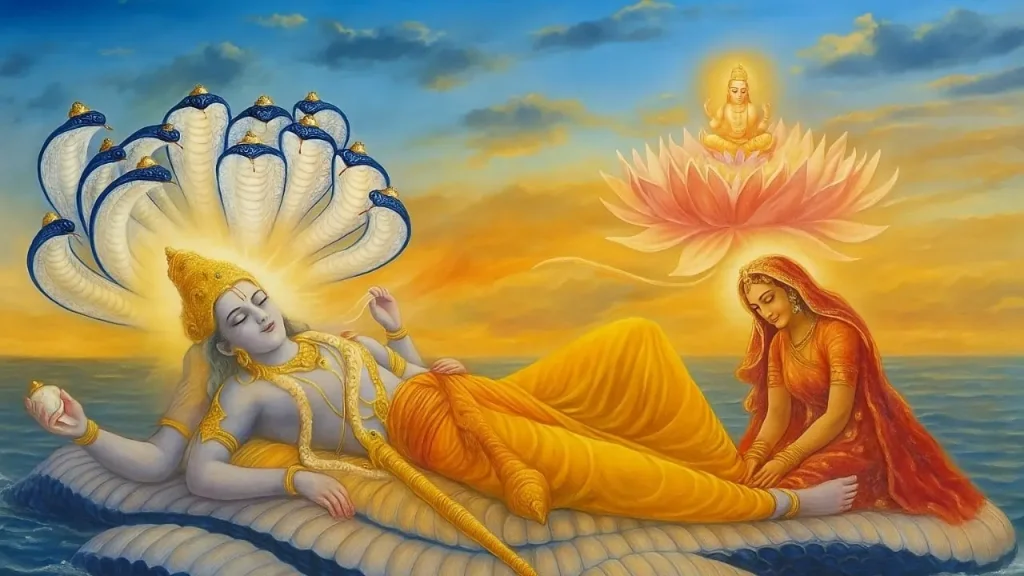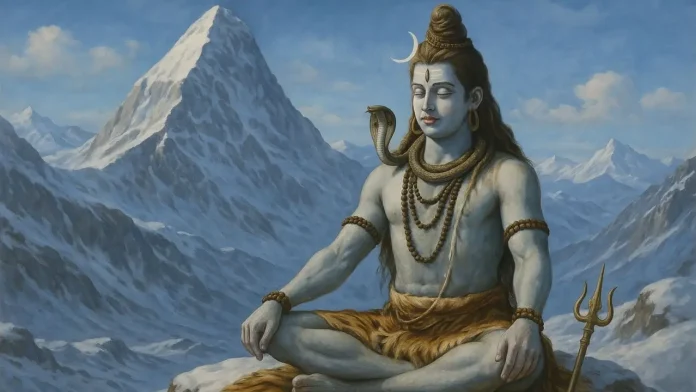Imagine Lord Shiva, trident in hand, stepping up to steer the universe as Lord Vishnu drifts into a divine slumber. On July 6, 2025, Chaturmas begins, marking four months when Shiva, the Mahadeva, takes charge of creation.
This sacred period, rooted in a timeless tale of devotion and duty, transforms how millions worship. Why does Vishnu rest, and why does Shiva rule? Let’s unravel the Chaturmas katha, its rituals, and why it’s a spiritual game-changer for 2025.
What Is Chaturmas?
Chaturmas, meaning “four months” in Sanskrit, is a holy period from Devshayani Ekadashi (July 6, 2025) to Devutthani Ekadashi (November 1, 2025).
Spanning Sawan, Bhadrapada, Ashwin, and Kartik, it aligns with India’s monsoon season. During these months, Lord Vishnu enters yoga nidra (cosmic sleep) in Ksheer Sagar, leaving Lord Shiva to manage the universe.
Hindus, Jains, and Buddhists observe this time with fasting, meditation, and spiritual discipline, avoiding auspicious ceremonies like weddings or housewarmings.
The Vamana-Bali Katha: Why Vishnu Rests
The story behind Chaturmas lies in Lord Vishnu’s Vamana avatar and King Bali. Bali, a generous but ambitious demon king, conquered the three realms—Earth, Heaven, and Patala Lok.
Despite his demon lineage, Bali was a devout Vishnu bhakt. Vishnu, as the dwarf Vamana, asked Bali for three steps of land. With his first two steps, Vamana covered the Earth and heavens. For the third, Bali offered his head, earning Vishnu’s admiration.
Pleased, Vishnu granted Bali a boon. Bali requested Vishnu’s presence in Patala Lok. Vishnu agreed to stay for four months annually, entering yoga nidra during Chaturmas.

Goddess Lakshmi, missing her husband, tricked Bali by posing as a poor woman to limit Vishnu’s stay to these four months. During this time, Lord Shiva takes over cosmic duties, ensuring the universe runs smoothly.
Lord Shiva: The Cosmic Caretaker
Why Shiva? Known as Mahadeva (“Great God”) and Gangadhara (“Bearer of Ganga”), Shiva is the destroyer and transformer in the Hindu trinity.
In Shaivism, he’s the supreme lord who creates, protects, and transforms. His ability to swallow the halahala poison during the Samudra Manthan shows his power to handle chaos, making him the perfect caretaker during Vishnu’s rest.
In Sawan, Shiva is believed to reside in Haridwar’s Daksha Mahadev Temple, his “in-laws’ home,” adding a cultural twist.
Rituals and Restrictions of Chaturmas
Chaturmas is a time for spiritual growth. Devotees follow strict practices to purify body and mind:
- Fasting: Avoid spinach in Sawan, yogurt in Bhadrapada, milk in Ashwin, and non-vegetarian food in Kartik.
- Meditation and Puja: Worship Vishnu and Shiva, read scriptures like Ramayana or Shiva Chalisa, and visit holy sites like Braj.
- Restrictions: No weddings, mundan, or housewarmings, as Vishnu’s absence makes these inauspicious.
- Jain and Buddhist Practices: Jains observe Varshayog, with monks staying in one place to avoid harming creatures during monsoons. Buddhists follow Buddha’s tradition of staying put and preaching.
The Gist of Chaturmas 2025
Short on time? Here’s the essence:
- What: Chaturmas, a four-month spiritual period from July 6 to November 1, 2025.
- Why: Lord Vishnu rests in yoga nidra; Lord Shiva manages the universe.
- Story: Vishnu’s Vamana avatar honored King Bali’s devotion, staying in Patala Lok for four months.
- Practices: Fasting, meditation, and no auspicious ceremonies like weddings.
- Significance: A time for spiritual growth, celebrated by Hindus, Jains, and Buddhists.
What’s your favorite Chaturmas practice?
- Fasting or dietary restrictions
- Reading scriptures like Ramayana
- Visiting temples or holy sites
- Meditation and puja
Poll embedded here: [Metroskope.in can integrate a poll widget to collect responses]
This poll engages your audience, sparking discussion about spiritual practices.
Why Chaturmas Matters
Chaturmas isn’t just a ritual—it’s a cultural cornerstone. For Hindus, it’s a time to deepen devotion through fasting and prayer, with Shiva’s worship peaking in Sawan.
Jains use it for Varshayog, minimizing harm to creatures, while Buddhists follow Buddha’s retreat tradition. X posts reflect the excitement, with users sharing, “Sawan’s Mondays are for Bholenath!” and “Chaturmas vibes = spiritual reset.”
The period’s festivals, like Krishna Janmashtami and Ganesh Chaturthi, unite communities in devotion.
What’s Next for Chaturmas 2025?
Starting July 6, 2025, Chaturmas will bring a spiritual wave. Sawan’s Mondays will see Shiva temples packed, especially in Haridwar and Varanasi. Key festivals include:
- Sawan Shivratri: Devotees offer water to Shiva lingams.
- Krishna Janmashtami: Celebrates Vishnu’s avatar, Krishna, despite his slumber.
- Ganesh Chaturthi: Honors Shiva’s son, Ganesha.
By November 1, Devutthani Ekadashi will mark Vishnu’s return, restarting auspicious events like weddings. Check our Sawan 2025 guide for festival details.
Join the Spiritual Journey
Chaturmas 2025 is your chance to connect with India’s spiritual roots. Will you fast, meditate, or visit a Shiva temple? Share your plans in the comments, and explore our latest spiritual stories for more on Hindu traditions.

